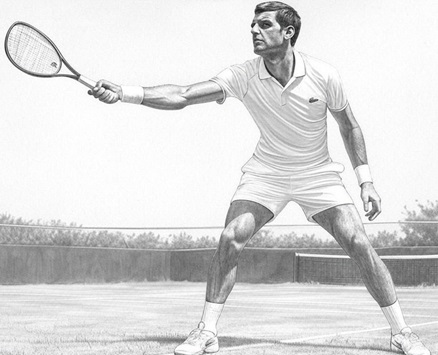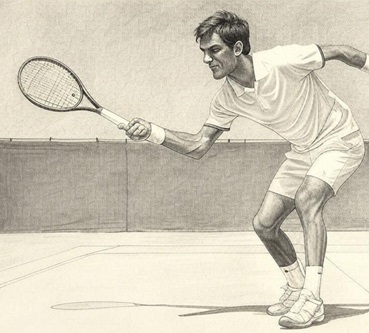Why It’s Hard to Correct a Bad Tennis Stroke and How to Approach It

Correcting a flawed tennis stroke presents significant challenges, rooted in both the physical execution and mental aspects of the sport. The journey to correct these errors is not only about altering muscle memory but also rethinking one’s entire approach to the game.
For example, consider a tennis player who has always used a pronounced wrist snap in their forehand, leading to inconsistency in shots. Mentally, this player might first need to accept that this wrist action, while familiar, is not optimal. They might employ visualization techniques, picturing themselves hitting a smooth, fluid forehand without the excessive wrist movement, focusing on the ball’s flight and the solid contact with the racket. This mental imagery helps in setting the intention for practice. They would then approach practice with patience, understanding that their forehand might initially feel awkward or even worsen. Through positive self-talk, they affirm their ability to adapt, focusing on small victories like better ball placement or increased control, rather than immediate perfection. Over time, this mental preparation transforms their approach, making the physical correction of their stroke not just a mechanical change but a holistic improvement in their game.
The Difficulty of Correction
Muscle memory plays a pivotal role in why bad strokes are hard to correct. When a player repeatedly performs a stroke, the body learns to execute that movement efficiently through repeated neural pathways. Changing this established pattern feels unnatural because the body resists what it perceives as inefficiency or discomfort. This resistance is compounded by the biomechanical complexity of tennis strokes. A stroke involves a chain reaction from the ground up, where each part of the body must move in harmony to transfer energy effectively from the feet to the racket. A flaw in any link of this chain can lead to poor shot execution, making corrections a matter of adjusting not just one movement but several interconnected ones.
Moreover, there’s a psychological component at play. Players often harbor a fear of altering techniques that have become their comfort zone, even if these techniques are suboptimal. The dread of potentially worsening their game before it gets better can be paralyzing. Additionally, without a clear understanding of the purpose behind each stroke, corrections can seem aimless, further complicating the learning process.

Strategies for Correction
The approach to correcting bad technique should be gradual and well-thought-out. Begin by revisiting the fundamentals of tennis strokes through slow, deliberate practice, focusing on the mechanics without the pressure of speed or power. This could involve shadow swings where the emphasis is on form rather than outcome, allowing the body to familiarize itself with new movements at a pace that doesn’t overwhelm the muscle memory.
Rather than attempting to overhaul everything at once, focus on one aspect of the stroke at a time. This could be the grip, the backswing, or the follow-through. By isolating elements, you give yourself time to adapt to each change before moving on to the next, reducing the likelihood of becoming overwhelmed or regressing.
Feedback is invaluable in this process. Using video analysis, players can visually track their progress or pinpoint where their technique deviates from the ideal. A coach’s input can be crucial here, offering insights tailored to individual styles, strengths, and weaknesses. Coaches can break down complex movements into digestible parts, provide real-time corrections, and offer encouragement through inevitable setbacks.
Mental preparation is equally important.
Mental preparation is equally important when it comes to correcting a bad tennis stroke, as the psychological barriers can often be as formidable as the physical ones. Tennis, like many sports, is not just a physical endeavor but also a mental battle where confidence, focus, and resilience play critical roles.
Embracing Mistakes as Part of Learning
One of the first mental shifts required is understanding that mistakes are not setbacks but steps in the learning process. The fear of making errors can lead to a conservative playing style or reluctance to try new techniques. By accepting that initial performance might dip as one learns, players can alleviate the pressure of perfectionism. This mindset encourages experimentation and learning from each hit, whether good or bad.
Visualization and Mental Rehearsal
Visualization is a powerful tool in sports psychology, often used by top athletes. Before even stepping onto the court, players should visualize executing the corrected stroke successfully. This mental rehearsal helps in creating a mental blueprint of the new technique, aligning the brain’s expectation with the body’s actions. It can enhance confidence in the stroke before it is physically practiced, making the transition to the new technique smoother.
Developing Patience and Persistence
The journey to correct a stroke can be long and fraught with frustration. Patience is key; understanding that change does not happen overnight helps maintain motivation. Persistence is about continuing to practice the new technique even when progress seems slow. This resilience is built through setting small, achievable goals rather than focusing on the end result, celebrating minor improvements to keep morale high.
Coping with Fear of Regression
Many players fear that changing their technique will lead to a temporary decline in performance. This fear can be paralyzing, keeping one stuck with ineffective strokes. Mental preparation involves acknowledging this fear and countering it with strategies like gradual application of new techniques in non-competitive or low-stakes environments. This allows the player to build confidence without the immediate pressure of competitive play.
Creating Positive Self-Talk
The internal dialogue players have with themselves can significantly impact their ability to adapt new techniques. Negative self-talk can reinforce the difficulty of change, while positive affirmations can build the mental fortitude needed for improvement. Encouraging phrases like « I’m getting better with each practice » or « I’m mastering this new technique » can transform the mental landscape, making the process of correction more enjoyable and less daunting.
Mindfulness and Focus
During practice, maintaining focus on the task at hand rather than worrying about past mistakes or future outcomes is crucial. Mindfulness techniques can help players stay present, concentrating on the feel of each stroke, the alignment of the body, and the intention behind each hit. This focus reduces the mental clutter that can interfere with learning and executing new skills.
Handling Pressure and Competition:
Once the new stroke begins to feel more natural in practice, the next mental challenge is applying it under the pressure of match play. Preparation here involves mental imagery of performing the corrected stroke in competitive scenarios, dealing with stress through breathing exercises, and perhaps even practicing in slightly stressful conditions to mimic the match environment.
In essence, mental preparation for correcting a bad tennis stroke involves reprogramming thought patterns, managing emotions, and fostering an environment of continuous learning. It’s about creating a mental space where growth is not only possible but anticipated, making the physical aspect of correction a natural extension of a well-prepared mind.
Praticing
Practice should be both repetitive and contextual. Drills that mimic match situations but allow for the focus to remain on technique are beneficial. These should gradually increase in complexity and speed as confidence with the new technique grows. Playing in low-pressure scenarios, where the focus can be on execution rather than winning, can also be a practical way to integrate changes without the stress of competition.
Lastly, physical conditioning should not be overlooked. Sometimes, the inability to adopt a correct technique stems from physical limitations rather than a lack of understanding. Improving flexibility and strength can facilitate the adoption of new movements, making what once was difficult feel natural over time.
Correcting a bad tennis stroke is not merely about changing how you hit the ball; it’s about reshaping your approach to the sport, requiring patience, precise practice, and a mindset geared towards long-term improvement. Through a structured, comprehensive strategy, players can navigate these challenges, ultimately enhancing their game and enjoyment of tennis.
